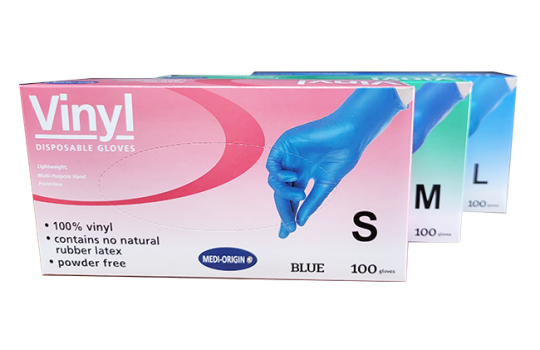How To Compare Different Types of Gloves
January 3, 2023 2023-01-03 10:35How To Compare Different Types of Gloves

<strong>How To Compare Different Types of Gloves</strong>
Workplace safety is crucial particularly when it comes to hand protection. Wearing protective equipment such as gloves is one of the most essential and effective methods for hand protection.
It can be challenging to distinguish between the different types of gloves and locate the type of glove that is best suited to your business and workplace needs.
Pharmpak seeks to dispel misconceptions about gloves and hand safety. We will define the technical terms used in the business and give you a handy checklist to keep in mind while you look for the ideal gloves for your business requirements. However, because every situation and glove is unique, if you have even the slightest question whether the glove you are using is appropriate for your business needs, please contact us, who are qualified to help our customers determine which glove would work best in any given circumstance.
At different workplaces, our hands can get into all kinds of hazardous circumstances. This means that a glove that may be suitable for one task may not offer sufficient protection for another.
Furthermore, it is quite challenging to physically compare two distinct gloves because the spec papers and chemical-resistant sheets from each business contain different information.
Thickness of the glove
Generally speaking, thickness is naturally associated with strength and quality in the safety business. However, this is just not the case when it comes to gloves, particularly disposable gloves.
Although it can be a driver, thickness is not the only deciding factor. The strength, quality, or chemical and puncture resistance of a glove cannot be accurately determined by its thickness.
It is simple to produce a glove “thick”—especially for disposable gloves—but if it is made cheaply or by a manufacturer who is unaware of the intricacies of glove manufacturing, the “thick” glove will still easily snap or snag when tugged or pierced.
Having a direct conversation with a glove expert and physically comparing and testing the gloves is the only method to determine which glove is of greater quality.
The best course of action is to call and speak with a glove or PPE expert; they will most likely determine which glove is ideal for you and then determine how to allow you to test the gloves in the most effective manner. Since every work, task, or job is unique, most glove manufacturers are aware that the best approach to obtain the finest protection is to speak with a specialist and try the gloves out.
The easiest method to determine the ideal fit for you is to physically compare and test different gloves. But a lot of the time, you might need to compare gloves based on their technical specifications and/or certifications. You may compare gloves by using a few insider strategies below:
Glove thickness in comparison
Several methods exist for measuring thickness. The unit of thickness known as a “mil” in U.S. is one thousandth of an inch (.001 inch). Micro Meters are what we use in Australia and Europe (Microns). A length measurement that is one millionth of a metre.
When determining the thickness of a glove, it’s vital to keep in mind that the findings can vary greatly depending on which area of the glove is measured. For instance, a thickness measurement made at the fingertips will almost always be far thicker than one made on the glove’s palm.
The palm of the glove should be used as the measurement according to industry standards. However, not everyone does, which contributes to the failure of utilising spec sheets alone to compare gloves. You should always be aware of the glove thickness between the fingertips and palm area.
How to Evaluate Glove Strength and Compare Gloves
The strength of a glove cannot be measured or compared using a standardised test. Depending on the situation, the concept of strength might vary greatly. It is challenging to apply one general rule to measure the “strength” of a glove because gloves are required in so many different jobs for a number of distinct protection demands.
The EN glove standards were developed for this purpose. To assess how “strong” a glove is, we can refer to the EN glove standards testing for a range of specific risks. Tests evaluating a glove’s ability to withstand abrasion, cuts, tears, chemicals, and punctures are the best indicators of its sturdiness.
How to gauge and compare glove cut, abrasion, rip, and puncture resistance. Without using technical terms, the fundamental description of these tests is;
- The glove’s ability to resist puncture risks is referred to as its puncture resistance. The more resistant, the higher the number.
- The likelihood that a glove may rip when it encounters snags or pull hazards is known as tear resistance. The glove will be more resistant the higher the number.
- The glove’s ability to endure abrasion risks is known as abrasion resistance. The glove is more resistant to a rough surface the higher the number.
- How well a glove can endure risks from sharp cuts is known as cut resistance. The glove will be more resistant to knives, sharp edges, and other objects if the number is higher.
To sum up, trying the gloves out in person is the practical method to compare gloves for thickness, strength, and quality. Use the EN Glove Standards if that isn’t an option. Nothing is more crucial than your safety, therefore make sure the manufacturer adheres to the standards.
Your hand safety will be jeopardised because many manufacturers conduct internal testing, and the results may be biassed or erroneous. Reach out to Pharmpak if you have any questions about your existing hand safety, and they will direct you to the best safety solution.





